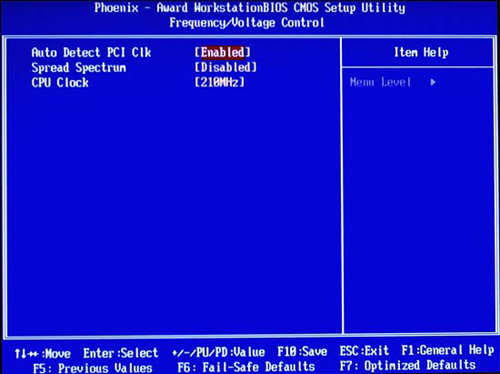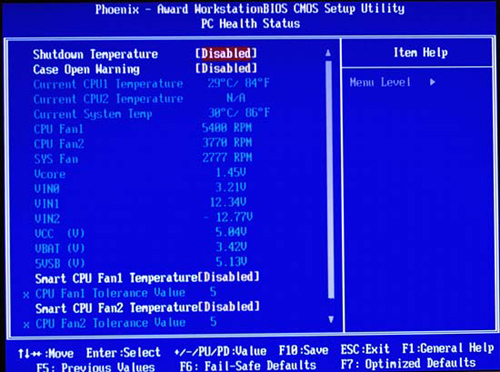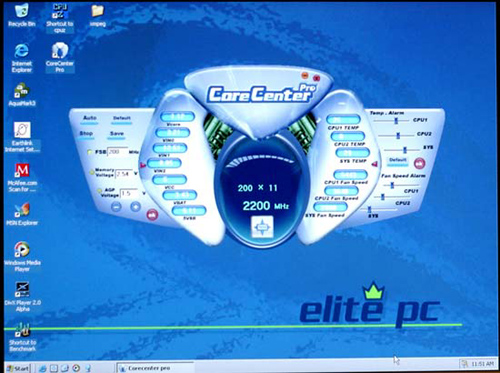Elite PC Titan FX: Setting New Standards in Gaming
by Wesley Fink on November 30, 2003 10:57 PM EST- Posted in
- Systems
Elite PC Titan FX: BIOS and Overclocking

The Titan FX uses the familiar Award BIOS on the MSI K8T Master 2 motherboard. The available options should be very familiar to the Gamer and Computer Enthusiast who are the target audience for the Elite PC Titan FX, so we will not repeat the obvious.

While there is a Frequency and Voltage control section in the BIOS, the only adjustment that can be made is to the CPU FSB, with a range of 200 to 233. There are no adjustments available at all for voltage.

This also extends to the memory timings options. While you can force memory speed, there are no adjustments available for memory timings. Fortunately, the MSI does read and set SPD timings properly, which is why we see the excellent 2-3-2-8 timings with the Mushkin High Performance ECC Registered memory.

A very complete selection of system monitoring functions is available in the BIOS for the MSI K8T. This includes the option to control fan speeds automatically. We strongly recommend you use these fan control options to set the system for automatic fan speeds controlled by system temperature.

The Titan FX also comes with MSI's Core Center Pro windows-based utility for system monitoring and overclocking control. Since there are so few real options for tweaking and overclocking on this Workstation board, Core Center is mainly useful as a monitoring utility that works in Windows. None of the overclocking controls appear to work, but it is possible to set monitoring options.
FSB Overclocking Results
We are not surprised that only very limited overclocking controls are available on a board that is aimed at the Workstation market. With so few controls, we really did not expect much in overclocking, but we were able to reach a raw speed of 211 (844FSB), or about a 6% overclock, with stability. Any setting above 211 caused memory failure. We have tested Mushkin and OCZ's registered memory to about 220 (DDR440) with slower timings on other motherboards.| Front Side Bus Overclocking Testbed Default Voltage |
|
| Processor: | Athlon64 FX1 2.2GHz |
| CPU Voltage: | 1.5V (default) |
| Cooling: | AVC/MSI Heatsink/Fan |
| Power Supply: | Sparkle 460W |
| Maximum OC: | 2320MHz (+6%) 211FSB |
We have been able to reach overclocks of about 230 (DDR460) by lowering the memory setting to 333 on nF3 boards as well. We suspect that if we had the ability to increase memory voltage or actually tweak memory timings, we might get better overclocks on this board.
Elite PC Titan FX: Stress Testing
We performed stress tests on the Elite PC Titan FX in these areas and configurations:1. Chipset and motherboard stress testing, conducted by running the FSB at 210MHz.
2. Memory stress testing, conducted by running RAM at 400MHz with 2 DIMM slots filled and at 400MHz with all 4 DIMM slots filled at the lowest memory timings possible.
Front Side Bus Stress Test Results:
A full range of stress tests and benchmarks were run to ensure the Titan FX system was absolutely stable at the overclocked FSB speed of 211. This included Prime95 torture tests, and the addition of other tasks like data compression, various DX8 and DX9 games, and apps like Word and Excel. Finally, we ran our benchmark suite, which includes ZD Winstone suite, Unreal Tournament 2003, SPECviewperf 7.0, and Gun Metal Benchmark 2. At default voltage, 211MHz was the highest overclock that we were able to achieve with the Titan FX while running these tests. Since failures at higher overclocks were always related to memory, we suspect that we could achieve a higher overclock if memory timings were adjustable on the MSI K8T Master-2 motherboard.Memory Stress Test Results:
The memory stress test simply tests the ability of the Titan FX system to operate at its officially supported memory frequency (400MHz DDR) at the lowest supported memory timings that the shipped Mushkin High Performance ECC Registered Modules will support:| Stable DDR400 Timings — 2 DIMMs (2/4 Dual-Channel DIMMs populated) |
|
| Clock Speed: | 200MHz |
| Timing Mode: | N/A |
| CAS Latency: | 2.0 |
| Bank Interleave: | N/A |
| RAS to CAS Delay: | 3T |
| RAS Precharge: | 8T |
| Precharge Delay: | 2T |
| Command Rate: | N/A |
We had no problem running the 2 DS 512MB DIMMs in Dual-Channel mode with complete stability. While the motherboard sets SPD timings only, the actual memory timings that were running were 2-3-2-8 as confirmed by CPU-Z, Version 1.20a.
Filling all available memory banks is more strenuous on the memory subsystem than testing 2 DIMMs, so we tried filling all 4 memory slots — 2 Dual-Channel banks — with Mushkin High Performance ECC memory. While the system would reach the initial boot screen, it could not complete a system boot. We thought perhaps that the SPD timings might be a bit aggressive for 4 DIMMs on the VIA K8T800 board, so we tried 4 x 512Mb Legacy Electronics Registered ECC DIMMs, which we have run in an nVidia nForce3 Reference Board with no problems. The Legacy registered memory has 2.5-3-3-6 timings, but the 4 DIMMs of Legacy memory also would not boot. We also could not get even 2 sticks of Legacy CAS 2.5 to boot on the MSI K8T Master. We then tried OCZ EC registered 3200 and Kingston ECC Registered 3200. Both these memories booted fine when we installed 2 DIMMs. The OCZ has 2-3-2-8 timings like the Mushkin, while the Kingston is based on Samsung chips and has 3-3-3-8 timings.
Finally, we tried 4 Kingston ECC Registered DIMMs, which we had pulled from another system. While 2 booted fine, we could not get 4 DIMMs to go past the initial boot screen. In the end, no combination of 4 DS 512MB ECC Registered DIMMs would work. It appears the MSI K8T Master-2 is very sensitive to the memory it is fed. Our advice is to plan to use 2 DIMMs, or to order the Titan FX with 4 DIMMs. Elite PC does offer this option and this should deliver the working 4 DIMMs if that is what you want. Do not plan to just grab 4 ECC Registered DIMMs for this board as there is no assurance that they will work properly.
Frankly, we have seen difficulty going beyond 2 DIMMs on VIA K8T800 motherboards for both Athlon64 and Athlon64FX Opteron. It appears that the chipset is very picky about the memory used beyond 2 DIMMs.










50 Comments
View All Comments
Wesley Fink - Monday, December 1, 2003 - link
#7 - While it is clear in the pictures in the review, I did not make specific mention that the MSI K8T Master motherboard requires a 24-pin connector (not a standard 20-pin ATX) and a 8-pin auxilliary power connector. This is the connector often used on other Dual-Processor, Workstation, and Server boards. As a result the choices for PS are more limited. In general, the 24-pin PS are higher quality.madgonad - Monday, December 1, 2003 - link
ElitePC makes good products.I've bought two over the past ten years and both are still running great (although not in my house). They have excellent prices for less robust systems if your wallet isn't blessed enought for the $3k+.
And I did enjoy reading a review exposing the prior Dell paid-advert for what it really was. Nice recovery Anandtech. Gave Dell every chance in the world and they still blew it.
tfranzese - Monday, December 1, 2003 - link
I don't think AMD has confirmed it and probably will never confirm it. It is most probably going to be something you see disappear in time because the FX was seemingly launched in a hurry to drive the nail into their 'performance crown' coffin.I've actaully seen no tests done with the FX's in pair, only read that they can be because the HT links were never disabled.
SUOrangeman - Monday, December 1, 2003 - link
RE: #9 and #10I too was intrigued by the multi-processor A64FX remark. This was a bigger question mark before the Opteron 248 arrived. Still, has AMD confirmed that the FX line will work in MP mode ... and will they support it? It's kinda like the MP vs. XP+mod situation without some confirmation from AMD.
-SUO
Boonesmi - Monday, December 1, 2003 - link
dang that is one very impressive system... for someone who doesnt want to build his/her own system, then this is about as good as it gets :)tfranzese - Monday, December 1, 2003 - link
#14, I think the tweaking is just eliminating bottlenecks such as HDD bandwidth by using striped 10k rpm SATA drives. Just right there you are increasing access time, lowering CPU utilization, and lowering write times.I don't think there is very much else done in terms of tweaking that usual enthusaists such as you or I do to a system we build. Hitting nice CAS times, overclocking, etc are all tweaks that net an enthusiast machine better performance over stock, not tweaked equipment.
ArvinC - Monday, December 1, 2003 - link
This system's scores are really impressive. I would really love to read an article discussing the "black art" of tweeking that some of these system builders use. I bet a lot of insight could be gained if one knew the exact system settings and tweeks builders like FNW, Voodoo, AlienWare, etc. use.Wesley Fink - Monday, December 1, 2003 - link
#1 and #2 - The card is a 256mb Radeon XT, and the info has been corrected.tfranzese - Monday, December 1, 2003 - link
#11, you seem very touchy. Anywho, you're pretty ignorant. Pioneer owns the DVD-R market in leadership, not Plextor - yet anyway. Also, there are few manufacturers who make their own drives and it's only foolish to pay more for the same drive just to have a certain name on it.destaccado - Monday, December 1, 2003 - link
#8 i said nothing about the writers being identical or not all i said is that they were trying to save a few dollars already by using generic equivalents.....if your spending 3g's you should be buying plextor 708's anyways....